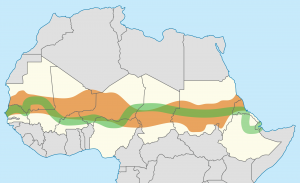31 Sub-Saharan Africa: Physical Geography – The Great Green Wall
“It’s really beautiful. It feels like God visits everywhere else, but lives in Africa.”
- Will Smith, American actor

Having learned about the Sahel in Chapter 27, let us consider the Great Green Wall, a remarkable plan in progress for protecting the environmentally fragile region.
The Great Wall of China is an architectural wonder winding over thirteen thousand miles; however, contrary to public expectation, the wall is not one lengthy piece but consists of numerous sections even in different regions of China.
In comparison and contrast, the Great Green Wall also is a man-made structure, but is made of live organic material and consists of one lengthy winding piece. The Great Green Wall will extend about 4350 miles through the Sahel, crossing Africa from the Atlantic Ocean to the Red Sea. The wall was first mentioned in the 1970s and 1980s, but did not become an official project until 2007. Spurred by the African Union, eleven countries agreed to fund and build the wall. Since then, participation has doubled, as the project moves forward.

So, what is the motive for building the Great Green Wall? Well, the Sahel is a region with a rapidly growing population, but a vulnerable environment. As the transition zone between the Sahara Desert and tropical forests, the asSahel is subject to climate swings, droughts, and desertification. Yes, without care, the Sahara Desert may expand southward into the Sahel. The Sahel was not always a dry and needy region. At times, the transition zone was lush with vegetation; however, conditions in the Sahel fluctuate as climate patterns vary. However, human activity has exasperated these changes for the worse. Climate change, spurred by human action, has produced hotter and drier settings there. Poor land management and overutilization of land resources decreased vegetation and soil cover prompting desertification. With denuded surfaces, wind erosion flew the topsoil away. Occasionally, policies hindered changes. For instance, in Niger, French colonial rules made trees property of the government, seeking to prevent farmers from cutting down trees for firewood; yet, as an unintended consequence, this rule prompted farmers to strive to have few or no trees on their properties. Drought limited the numbers of livestock and reduced the yield of cereal grains.
How will the Great Green Wall improve life? First, it can do so, partly by reinforcing improved farming choices. In Niger, after independence and then end to French rules about trees, farmers progressively allowed trees on their lands, progressively recognized agricultural benefits of having the trees there. In areas like those in Niger, the Great Green Wall was not an artificial structure, but became a natural by-product of land use improvements already happening.
Second, the addition of millions of drought-resistant tree roots to the Sahel dramatically will reduce soil erosion, helping keep fertile top soil in the region. This will promote greater crop yields that will feed the burgeoning population. In addition to subsistence agriculture, surplus yields will promote regional agricultural trade.
Third, the wall of millions of trees will act as a carbon sink, pulling carbon dioxide (CO2) from the air, thereby reducing the quantity of this greenhouse gas in the atmosphere. Diminishment of CO2 in the air is one of the world’s most vital challenges in rebuffing global warming.
Fourth, this international cooperation crosses numerous ethnic lines and connects Muslim populations. (In Africa, Christianity is the main religion for African regions south of the Sahel.) While religion may act as a unifying force, in Africa the vast number of ethnic groups or tribes inhibits inter-regional cooperation. However, the economic benefits of the Great Green Wall are expected to act as bonds between ethnic groups, as all would gain from agricultural productivity, increased food supply, expanded trade, and diversified economies. Interethnic cooperation itself can be a great improvement in the region.
Fifth, while the woes of the Sahelian peoples cry for humanitarian action, Europe and other more prosperous regions face indirect challenges of the Sahel’s conditions, as some of these peoples do seek to migrate northward to Europe. When drought in the Sahel prompts hardships, people of the Sahel also may become refugees to other African countries, straining those locations.
Sixth, increasing tree cover and reducing wind-blown dust will tend to increase land temperatures, thereby creating a greater differential between sea temperatures and coastal areas. This differential tends to increase monsoon patterns, bringing more precipitation to coastal regions. In this way portions of West Africa could gain increased rainfall in areas, thus aiding agriculture.
We could go further, given that of the seventeen 2030 UN Sustainable Development Goals, the Great Green Wall supports fifteen; for instance, it seeks #2 – zero hunger and # 13 – climate action. Clearly, the Great Green Wall has many positive attributes, although it is far from completion.
Did you know?
Curiously, in addition to its Great Wall, China also has a Green Wall project, building windbreaks in the Gobi Desert. The project began in 1978 and expects to extend 2800 miles by 2050.
There is a film titled The Great Green Wall from 2019. Here is a trailer for the film – https://www.youtube.com/watch?v=kB1qK_yBVxU
Cited and additional bibliography:
Dessus, Mathieu. Niger. December 21, 2006. Photo. https://www.flickr.com/photos/mathieudessus/358696205/.
Gramling, Carolyn. “Africa’s ‘Great Green Wall’ Could Have Far-Reaching Climate Effects.” Science News (blog), January 3, 2022. https://www.sciencenews.org/article/africa-great-green-wall-trees-sahel-climate-change.
Great Green Wall. “The Great Green Wall.” https://www.greatgreenwall.org/about-great-green-wall.
Morrison, Jim. “The ‘Great Green Wall’ Didn’t Stop Desertification, but It Evolved Into Something That Might.” Smithsonian Magazine. August 23, 2016. https://www.smithsonianmag.com/science-nature/great-green-wall-stop-desertification-not-so-much-180960171/.
Sevgart. “Great Green Wall Map – Wikipedia,” January 6, 2021. Attribution-Share Alike 4.0 International license. https://commons.wikimedia.org/wiki/File:Great_green_wall_map.svg.

